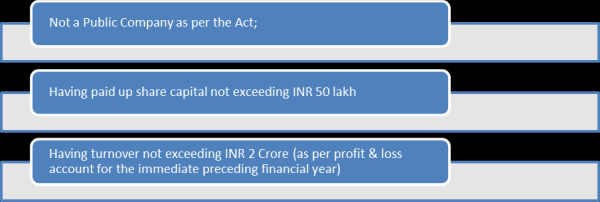INTRODUCTION:
Merger and amalgamation helps the companies to combine themselves as a part of corporate restructuring tool for the purpose of expansion, diversification, boosting growth, achieving economy of scale, consolidation of holdings at one level, tapping new area / sector etc.
Unlike the erstwhile Companies Act, 1956, the term "Merger" is not strictly defined in Companies Act, 2013 also (for brevity "Act").
Section 230-234 of the Act deals with Compromise, Arrangements and Amalgamations, out of which section 233 of Act read with rule 25 of Companies (Compromises, Arrangements and Amalgamations) Rules, 2016 (for brevity "Merger Rules") deals with merger or amalgamation between (i) Small Companies or (ii) Holding company & its wholly owned Subsidiary Company (for brevity "specified class of companies").
Merger or Amalgamation of specified class of companies under Section 233 of Act is popularly known as "Fast Track Merger", which is dealt by Regional Director pursuant to power delegated in its favor.
Interestingly, the heading of section 233 of Act only hints for merger or amalgamation of certain companies, however, as per section 233(12) of Act, demerger or compromise / arrangement among shareholders or creditors of specified class of companies may also be included under Fast track route.
APPLICABILITY:
As per provisions of Section 233 of Act, following two classes of companies can enter into merger or amalgamation by following Fast track route:
- Two or more Small Companies as defined under section 2(85) of Act; or
- Holding Company and its Wholly-owned subsidiary company.
As per Act, Small Company means a company, which meets the following criteria simultaneously:

Further, following class of companies shall be excluded from the definition of Small Companies:
- Company which is holding or subsidiary company;
- Company registered under Section 8; or
- Company or body corporate governed by any special act.
PROCESS OF MERGER OR AMALGAMATION:
The process of Fast track merger is being divided into following 3 stages with view of practical understanding:
- Pre-merger steps;
- During merger steps;
- Post-approval steps.
1. Pre-merger steps:
- To check whether Memorandum of Association ("MoA") has authority to enter into arrangement or amalgamation. If the MoA does not have such authorization, then alter the MoA suitably by convening and approving notice of general meeting;
- To appoint the IBBI Registered Valuer by board for obtaining valuation report for determining share exchange ratio (Valuation report would only be required in case of merger or amalgamation entering between Small Companies)
- To approve the availing of following non-audit services from respective auditors’ u/s 144 of the Act and to fix their fees for the same:
- obtaining of certificate from auditors of respective companies certifying that accounting treatment of the proposed Scheme of Amalgamation is in conformity with the accounting standard prescribed under Section 133 of the Act ;
- obtaining of Auditor’s report on the statement of assets and liabilities;
- After the drafting of Scheme, the Physical board meeting of both Transferor and Transferee Companies should be held for following purposes:
- To take note of the Valuation report along with Share exchange ratio, if required;
- To approve Scheme of Amalgamation and give necessary authorization; (File MGT -14 u/s 179 of Act as per applicability)
- To take note of Auditor’s Accounting treatment certificate u/s 133;
- To approve the latest Statement of Assets and Liabilities (prepared in format as annexed with Form CAA.10);
- To take note of Auditor’s report on Statement of Assets and Liabilities;
- To approve draft of Form CAA.10 i.e. Declaration of Solvency and give authority for signing of same;
|
2. During merger steps:
- After approval of Scheme of Amalgamation by Board, following documents should be filed with Registrar of Companies, Official Liquidators, Income tax department ("Authorities") for inviting their objections or suggestions on the Scheme of Amalgamation:
- Notice in physical Form CAA.9;
- Declaration of Solvency in physical Form CAA.10 along with Audited Statement of Assets and Liabilities;
- Certified Copy of Scheme of Amalgamation;
- Certificate of Accounting treatment u/s 133 given by Auditor;
- Board resolution approving the Scheme;
- Power of Attorney or Board resolution in favour of professional for appearance before various authority
- Form GNL-1 with RoC after annexing all above documents along with challan;
|
- After the expiry of 30 days from notice given in Form CAA.9 to authorities, hold another board meeting (either physical or through video conferencing or pass circular resolution) of Transferor and Transferee Companies for following purposes:
- To take note of the observations or suggestions letter, if any, received from respective authorities; If no objection or suggestion letter is received, then the Scheme of Amalgamation would be treated as final Scheme;
- To take note of the List of Creditors of Transferor & Transferee Company (as on cut-off date) duly certified by Chartered Accountant or Auditors of the respective Companies;
- To approve and send Notice of general meeting containing details as per Rule 25(3) of Merger Rules for obtaining consent of members holding at least 90% of total paid up capital;
- To approve and send Notice of Creditor’s meeting containing details as per Rule 25(3) of Merger Rules for obtaining consent of majority creditors representing nine-tenths in value of the creditors as on cut-off date;
Alternatively, in case of creditors, the Company may take consent from the creditors (as on cut-off date) by way of obtaining no objection Affidavits instead of calling the creditor’s meeting.
|
- After holding the general meetings of Transferor and Transferee Company for approving the Scheme, copy of the resolution should be filed in Form MGT-14 by respective companies’ u/s 117 of Act.
|
- Within 7 days of conclusion of meeting of members and creditors for approving the Scheme, the "Transferee Company" would file following documents with Regional Director, Registrar of Companies and Official Liquidator having jurisdiction over the respective companies:
- Physical Form CAA.11;
- Certified Copy of Scheme of Amalgamation;
- Board Resolution approving the Scheme;
- Notice of general meeting and creditors meeting sent in accordance with section 233(1)(a);
- List of shareholders as on record date who were eligible to attend the general meeting;
- Signed Minutes of general meeting approving the Scheme;
- List of Creditors as on cut-off date duly certified by Chartered Accountant who were eligible to attend the general meeting or to give NoC by way of Affidavits;
- Signed Minutes of creditors meeting or requisite NoCs by way of affidavits approving the Scheme;
- Certificate of Accounting treatment u/s 133 given by Auditor;
- Form GNL-1 with RoC after annexing all above documents
Above documents are to be filed by Transferee Company with Regional Director through E-Form RD-1 within 7 days of obtaining approval of members and/or creditors on Scheme.
|
- If no objection from RoC and Official Liquidator is received within 30 days of filing of Form RD-1, the Regional Director would approve the Scheme of Amalgamation by issuing confirmation order in Form CAA.12.
|
- Transferor and Transferee Company should file the certified copy of order in Form INC-28 along the copy of Scheme within 30 days of receipt from Regional Director.
(Please ensure that no other E-Form/ return is pending for filing or approval with RoC by Transferor Company or Transferee Company)
|
3. Post-approval steps:
For purpose of implementing the Scheme after approval, following major steps should be followed by Transferee Company:
- After amalgamation & pursuant to the Scheme, the Capital Clause of Memorandum of Association of Transferee Company should be amended by merging the Authorized Capital of dissolved Transferor Company
(For this, no shareholders’ approval would be required as the alteration is by virtue of Scheme of Amalgamation)
|
- Transferee Company will preserve all Minutes, Register and Record of Transferor Company for life time
|
- Intimation of amalgamation should be given to following Departments / offices along with Certified Copy of Order and Scheme:
- Income Tax Department;
- GST Department;
- All Banks, where A/c of Transferor and Transferee Company are being maintained;
- Intimation to Vendors / suppliers of Transferor Company;
- Intimation to ESI Department, if required;
- Intimation to PF / Gratuity Department, if required;
- Intimation to Insurance Companies;
- Revenue department for adjudication of Stamp duty;
- Such other department.
|
- Revised balance sheet of Transferee Company would be prepared reflecting all assets and liabilities being transferred pursuant to merger w.e.f. Appointed date
|
- Transferee Company will take over all assets and liabilities of Transferor w.e.f. Appointed date
|
- Cross Investment/ Loan / Advances made or given by Transferee Company into Transferor Company would be cancelled
|
- Pending legal proceedings by or against the Transferor Company shall be continued by or against the Transferee Company.
|
- Upon The registration of the scheme, Transferor Company or Companies shall be deemed to have the effect of dissolution without process of winding-up
|
- The fee, if any, paid by the transferor company on its authorized capital prior to its merger or amalgamation with the transferee company shall be set-off against the fees payable by the transferee company on its enhanced authorized capital due to merger or amalgamation.
|
CONCLUSION:
The simplified process of Fast track merger and cost-benefit analysis of such route viz.a.viz. NCLT route is definitely encouraging the corporate entities to undertake corporate restructuring activities and help them in achieving the rational of Scheme.
The author can also be reached at acslakhan@gmail.com










 CAclubindia
CAclubindia
